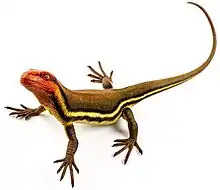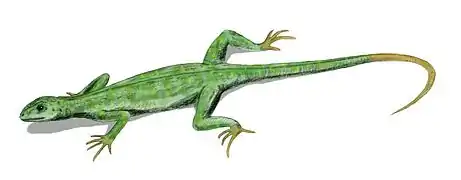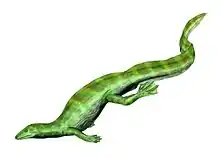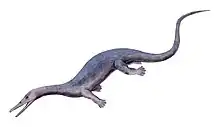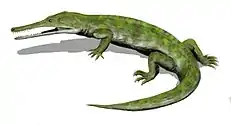Paleothyris
Paleothyris was a small, agile, anapsid romeriidan reptile which lived in the Middle Pennsylvanian epoch in Nova Scotia (approximately 312 to 304 million years ago). Paleothyris had sharp teeth and large eyes, meaning that it was a nocturnal hunter. It was about a foot long. It probably fed on insects and other smaller animals found on the floor of its forest home. The reason that they were able to do this and hunt so well was not only due to the fact that they hunted in the dark, but because they had a long head structure which helped them catch small, quicker prey. Paleothyris was an early sauropsid, yet it still had some features that were more primitive, more labyrinthodont-like than reptile-like, especially its skull, which lacked fenestrae, holes found in the skulls of most modern reptiles and mammals.[1]
| Paleothyris | |
|---|---|
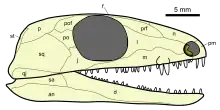 | |
| Skull diagram | |
| Scientific classification | |
| Kingdom: | Animalia |
| Phylum: | Chordata |
| Class: | Reptilia |
| Genus: | †Paleothyris Carroll, 1969 |
| Species: | †P. acadiana |
| Binomial name | |
| †Paleothyris acadiana Carroll, 1969 | |
See also
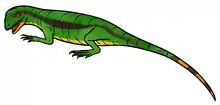
- Westlothiana, from 335 million years ago, either an early amniote or a sister group to the amniotes
- Casineria, from 340 million years ago, a basal amniote.
- Hylonomus, from 312 million years ago, another early anapsid reptile
- Petrolacosaurus, from 302 million years ago, the first diapsid reptile
- Archaeothyris, from 306 million years ago, an early synapsid (proto-mammal)
- Carboniferous tetrapods
References
Arjan, Mann, et al. “Carbonodraco Lundi Gen Et Sp. Nov., the Oldest Parareptile, from Linton, Ohio, and New Insights into the Early Radiation of Reptiles.” Royal Society Open Science, 27 Nov. 2019, royalsocietypublishing.org/doi/10.1098/rsos.191191.

